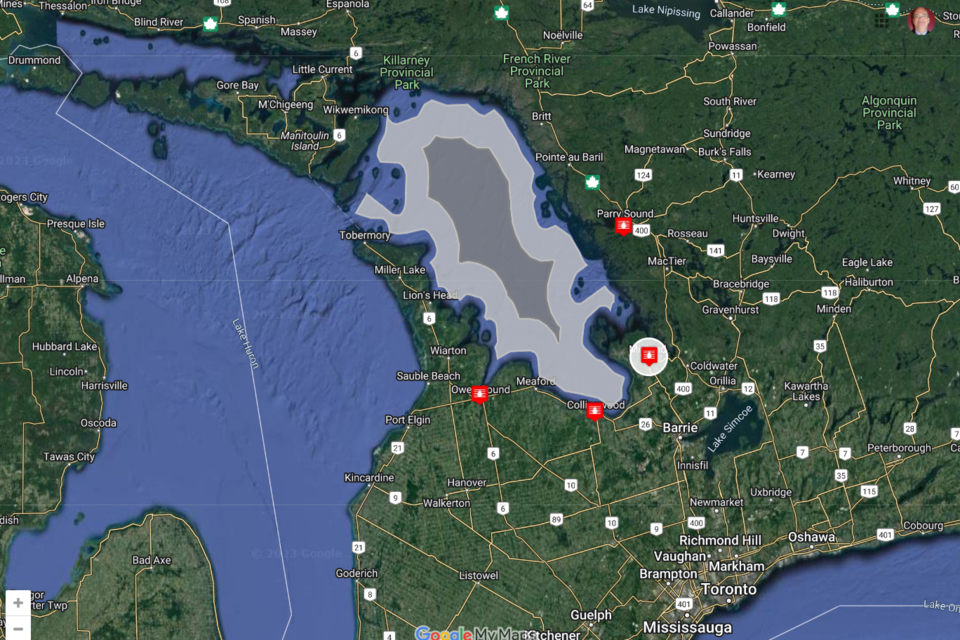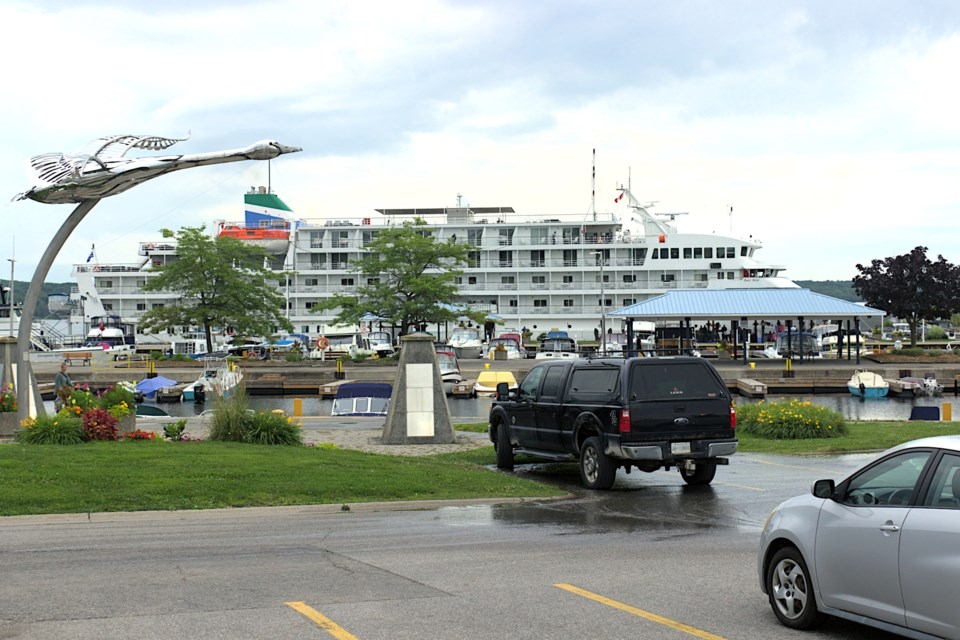Cruise ships provide a valuable commodity to the tourism areas of Georgian Bay, bringing in visitors to shop locally, as well as visibility and a spotlight on the global stage.
The Pearl Mist is one such luxury vessel, able to transport 210 passengers and 70 crew members throughout the warmer seasons on excursions throughout the Great Lakes. Although its cabins are large, it ranges on the smaller size of cruise ships at roughly 100 metres in length, allowing it into places large cruise ships can’t access.
Non-garbage waste product from cruise ships, simply put, can be designated as either sewage (mostly human) or grey water (from machinery).
Environment groups claimed that in 2019, inadequately treated pollution from cruise ships was dumped into the Pacific Ocean of Canada at the amount of 31 billion litres, according to Reuters.
Transport Canada announced voluntary environmental measures for cruise ships in April of this year, before making them mandatory in late June; enforcement and a $250,000 maximum penalty would be imposed on non-compliant vessels.
Georgian Bay is connected to the east side of Lake Huron and is roughly a third of its size. Its largest entry and exit point is in the gap north of Tobermory, although passage to the North Channel is also frequented.
Within Georgian Bay are the port towns of Midland and neighbouring Penetanguishene, Collingwood, Parry Sound and Tobermory, among others, as well as the City of Owen Sound. These ports are advertised as destinations on the routes of various cruise ships.
Regarding waste disposal, Transport Canada mandated cruise ships avoid discharging grey water and sewage within three nautical miles of shore when possible, that the grey water is treated with sewage before discharge in the three- to 12-nautical-mile distance offshore as much as possible, and that they use an approved device to treat sewage between three and 12 nautical miles offshore.

Through an image created by Village Media data reporter Patrick Cain, available here, the near-shore three-nautical-mile and the deeper, 12-nautical-mile distances from Georgian Bay land can be viewed. The Pearl Mist specifically has a route throughout 2023 from Midland to Parry Sound close to shore before heading into the North Channel.
MidlandToday contacted Connecticut-based Pearl Seas Cruises several times with questions regarding any impact the June 2023 mandatory regulations would have on the Pearl Mist, its ability to retain or dispose of waste within Georgian Bay, and the fairness of the government regulations on its industry.
“I can tell you that Pearl Seas Cruises’ small ship, the Pearl Mist, has been cruising the Great Lakes and surrounding U.S. and Canadian coastal regions since 2014, and we have had a long and positive relationship with Midland,” stated public relations manager Alexa Paolella through email.
Additionally, Paolella committed to best practices for places sailed by company vessels, and shared a link to the sustainability pledge from cruising coalition Cruise the Great Lakes (CTGL).
Karen Mealing, the Town of Midland’s manager of culture and community, told MidlandToday that, according to CTGL in 2022, “No unlawful discharge occurs to Great Lakes waters, and solid waste is retained on board until a port of call where it can be handled by local municipal waste providers.”
“At the moment,” said Mealing, “neither the Midland Harbour nor Midland Bay Landing have the infrastructure to transfer waste, sewage and/or grey water to town facilities.”
MidlandToday contacted the other port municipalities of Georgian Bay for their disposal capabilities. Collingwood, Parry Sound and Penetanguishene do not have waste transfer infrastructure at their ports, Tobermory cannot accommodate cruise ships for waste removal at its facilities, and Parry Sound does offer a garbage bin on their dock for offloading.
Owen Sound officials stated they had a dedicated sewer connection for the 110-metre Chi Cheemaun ferry, servicing nearly 650 passengers and more than 140 vehicles, as well as a dumping station at the Georgian Shores Marina that discharges into the city’s sewage system.
Instead of having an environmental conservation authority, Midland and Penetanguishene are just two of eight joint municipalities under the umbrella of the Severn Sound Environmental Association (SSEA).
“Severn Sound was once a Great Lakes Area of Concern (in 1987), one of the most polluted areas on the Great Lakes,” said Julie Cayley, executive director of the SSEA.
She told MidlandToday that through great effort from all levels of government and a large financial investment, Severn Sound was delisted in 2004. In the two decades since, the SSEA was able to secure a recent provincial grant to dive into data and see the post-delisting state of the water quality.
“The increased use of our waters by the cruise ship industry is relatively new on our radar,” Cayley said. “This is a relatively new occurrence in Severn Sound and, although it was on our radar, we do not currently have the resources to do an exhaustive look into the industry and the ships that are visiting us here in Severn Sound.”
Between Cayley and the Great Lakes Cruise Association (GLCA), she noted they “were very interested in our SSEA story, and share the desire for good water quality and a healthy ecosystem.”
It was a sentiment echoed by Stephen Burnett, executive director of the GLCA.
“Given that not every port of call can accept waste, the ship’s management plan their routes to include calls at ports where waste facilities are available,” he said.
“One of the most powerful influences to ensure cruise lines work within the guidelines are their guests and their loyal customers. Given the power of public media, any cruise line not adhering to the guidelines would rapidly lose its client base and be heading out of business.”
Pearl Mist is scheduled to visit Midland eight times in 2023, including overnight stays.
Mealing pointed out that when a cruise ship is in harbour, a secured area with fencing is maintained around the vessel “per Transport Canada regulations, as it is an international vessel visiting port.”
Upon arrival, the Midland Legion’s Pipes and Drums greet visitors, who are also treated to butter tarts before going on shore excursions.
“Midland is an ideal and attractive destination for cruise ships as the area is rich in history and culture, local attractions provide memorable experiences for visitors, and we have a vibrant downtown core,” said Mealing. “Tourism is one of our economic pillars and cruise ships play an important role in attracting international visitors to Midland.”
A 2019 provincial cruise tourism brochure cited Midland as “the largest freshwater marina in the world.” Midland had looked into a Great Lakes cruise strategy plan in 2018 during the previous term of council, with former mayor Stewart Strathearn championing the plan as well as efforts to make Midland Bay Landing a potential terminus for larger cruise ships.
Currently, the cruise ship page on the Town of Midland website lists the Midland Bay Landing dock as being able to handle a maximum vessel size of 270 metres in length, with depths ranging between 6.4 and 8.5 metres.
“We lack the ability to host larger vessels such as the Ritz-Carlton cruise ship because our town dock is not long enough,” Midland Mayor Bill Gordon told MidlandToday through email.
“Our sea wall is in rough shape — to put it mildly — and the retention of all 1,100 metres of our waterfront is a part of the current waterfront plan that nobody wants to give up.
“With estimates from $10 million to 20 million needed to rebuild our sea wall to make it both functional as a dock/customs office for large cruise ships that could see Midland as turnaround port, as well as contiguous waterfront access to the water with a variety of shoreline improvements, we will need to factor this into the discussions about next steps and priorities for the 40-acre waterfront property.”
Gordon said philanthropic and corporate sponsor donations, government grants, and municipal taxes would “help us realize the mix of economic development lands and multi-use recreational space that is an anticipated compromise and outcome of the ‘rethink’ (pause on MBL development).”
Discussions on cruise ships in Midland’s future would resume in the fall with the inclusion of the town’s new CAO and the community, said Gordon. As well, he welcomed early and informal discussions on the project with interested parties.



